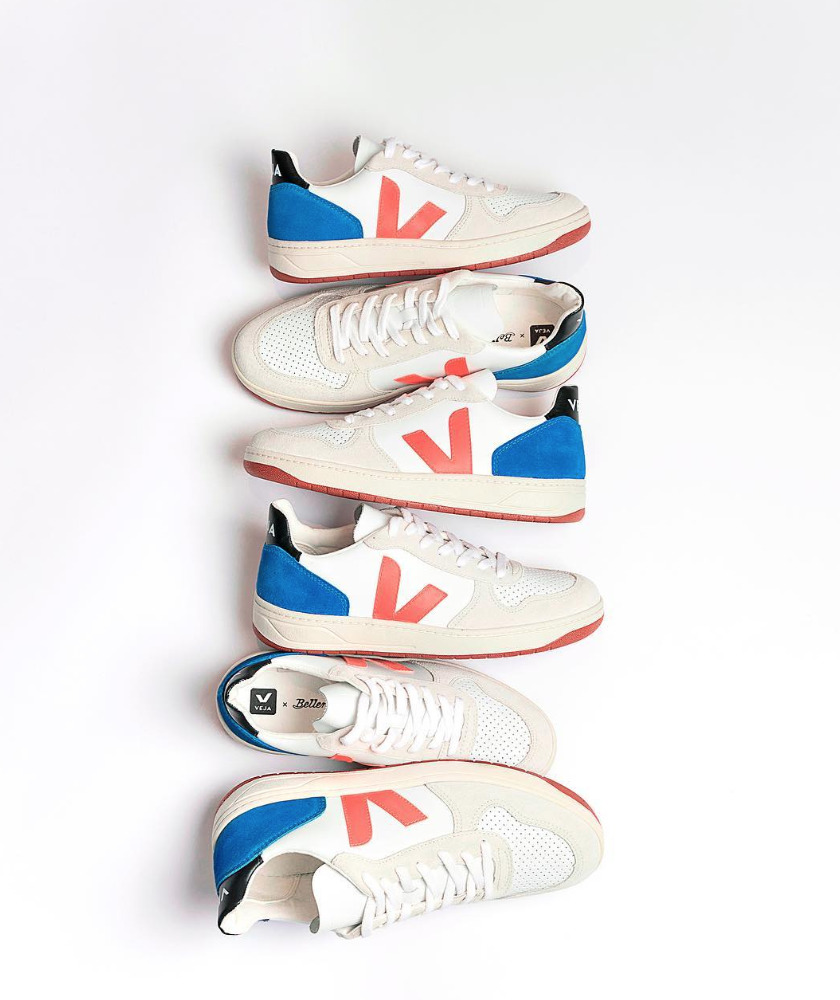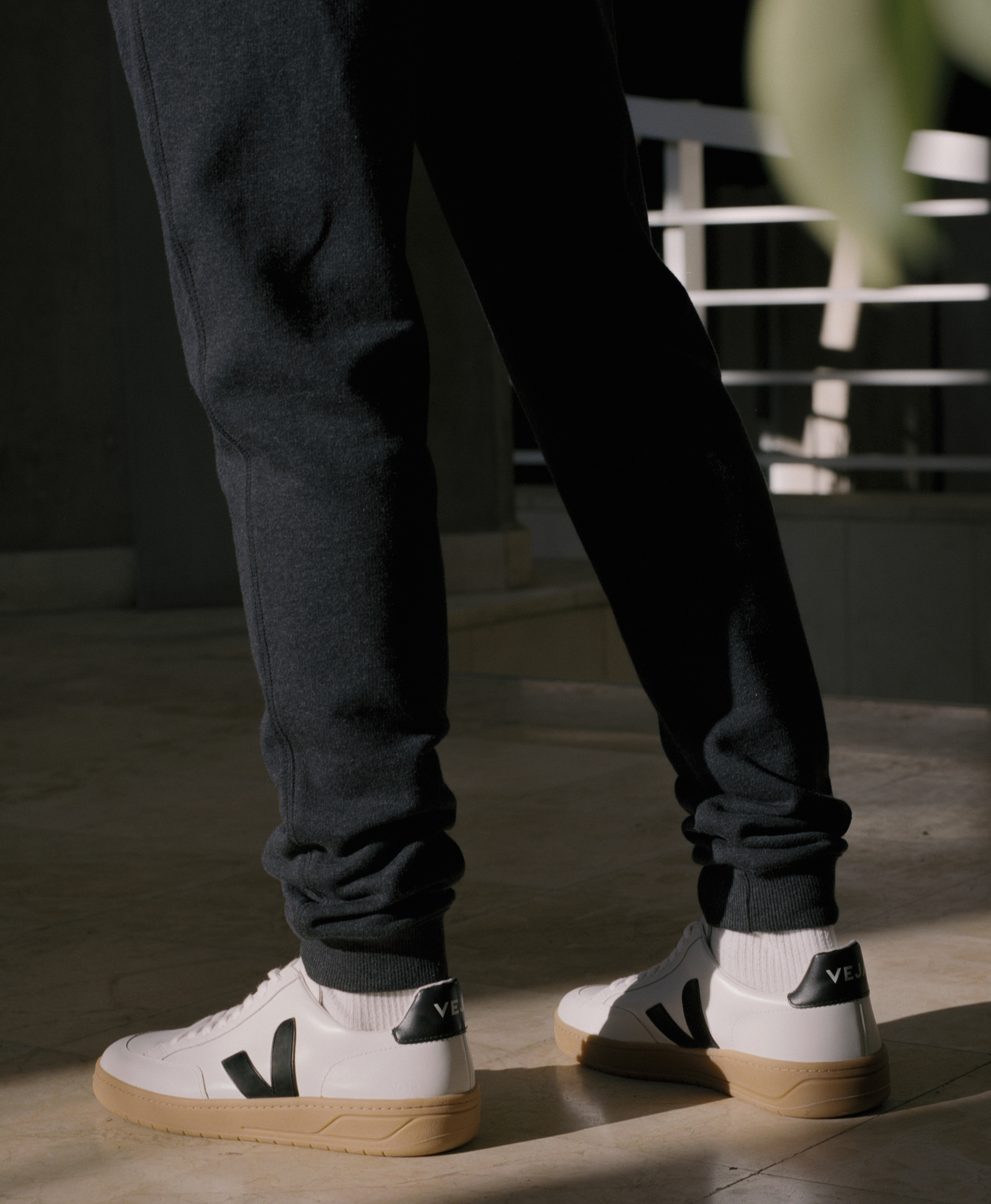At a glance
To kick off Volume I of S & S Spotlight, a series that delves into the stories of sustainable brands, there is no better advocate than Veja sneakers. Veja, translates from Brazilian to ‘Look’ and is a brand that combines sleek designs suitable for the streetwear fanatics with socially responsible practices integrated throughout their farming, production, distribution, wear phases and organisational structure. This spotlight feature attributes specific attention to Veja’s admirable levels of transparency along its supply chain to drive value for communities as well as consumers.
Founded in 2005, Veja’s timeless designs are intended to stand the test of time and be worn by the purchaser in a decades time and have been spotted on the likes of Meghan Markle and Emily Ratajkowski. This small company has experienced tangible growth having sold 1.7 million pairs since 2004 and grown to hire 70 employees. In this time, the Veja Project has used a staggering 365 tonnes of organic cotton within its production whilst simultaneously reintegrating over 200 professional workers, proving the brand has soul as well as soles! The project harvests organic cotton ethically from Brazil and Peru with a deep rooted connection to the communities responsible for farming it and respect for the land utilised in the process. Veja’s agro-ecological methods practiced amongst producers showcase a midas touch whereby they leave the soil richer than before it was farmed and cultivated. The organisation seeks to slash out the labour contractors from the production process, who are predominantly responsible for imposing poor working conditions with few rights and safety regulations for the farmers, and instead work directly with producers to produce the collections.




In focus
Organisational practices
Upon closer inspection, the organisational practices of Veja are highly laudable, so here is a snippet unravelling their sustainable, value driving strategy!
Rubber
Veja trainers use up to 18-22% natural rubber which is grown in the Amazon rainforest. The project seeks to protect the forests that support production through their procurement and purchasing. They do this by paying above average market prices to source wild Brazillian rubber that creates the components of the models. To put it into perspective, in comparison to the price of synthetic rubber counterparts that cost approximately $1.35 per kg, Veja actively choose to pay $2.77.
The communities who produce Veja’s wild rubber, known as the ‘Seringeuiros’ have developed innovative techniques that allow the material to reach a higher purity. This, in turn, has elevated the value of the project through technical and social innovation as the Seringeuiros sell this newly constructed material and semi finished product to other producers and actively promotes a credible and sustainable alternative to synthetic rubber across the industry!
Transparency
Veja has a distinct competitive advantage from other market players in regards to its levels of transparency.As aforementioned, directly working with farmers allows the company to set a price for longer term contracts of 1-3 years for their farmers that are de-correlated from typical market prices. This not only provides greater insurance for the communities but enables the growers to reinvest their earnings as it pre-finances harvests by as much as 40%. The project takes pride in being fair trade since inception and publishes its contracts, fair trade documents, chemical tests and organic labelling certifications which can be located on their website. For the elements of the designs that are not yet chemical free such as dyes, they ensure these are approved by REACH (Registration, Evaluation, Authorisation and Restriction of Chemicals) that regulates chemical substances effects on society/environment.
Fair trade
The sustainable ethos of the project seeks to balance the commercial transactions between producers and consumers of Veja sneaks to forge strong commercial bonds and increase producer income. By omitting any stakeholders that may manipulate labour conditions in the name of profit, their direct interactions see the company pay a €0.5 premium per kilo of harvested cotton and on average in 2017 purchased cotton for twice the market price!
Limits
Veja are void of green washing, which, amongst a sea of large brands trying to attract customers with faux green marketing should be applauded. The brand openly professes to areas where they are limited in scope for what they can achieve in certain stages of the production. For example, the laces for the models are not organic cotton and they do not directly source the metal of eyelets for straps and laces. As a consequence of weather prohibiting events such as extreme droughts in 2015/2016, the organic cotton that would usually be sourced was unobtainable and therefore the product development team sourced recycled cotton (hardly a punishable crime).
The business is transparent in its attempts to mitigate the impact of their trainers but have compromised in order to pursue quality. Despite their attempts to use natural dyes in 2012/2013 for 40% of production, in order to not sacrifice properties of the shoes, Veja sneakers use non-natural pigmented dyes which are REACH approved.Similarly, in their approach to the procurement of leather between the years of 2008-2015, 100% of their leather was vegetable tanned however the level of material was not satisfactory for the brand so they switched this up but again all leather used is approved by REACH.
The Veja leather focuses on traceability and chemical transparency and is not sourced from Amazon areas in Brazil which have been deforested harmfully for cattle production. In treating the leather, they use an audited tannery which has been awarded the highest accolade of Gold, certified by the Leather Working Group Organisation. This allows for the rigid monitoring of standards and ensuring chrome is not used in tanning stages which prevents toxicity for both the product and the manufacturing process.
To date, over 25% of their models are 100% vegan and in 2018, 20 of their 81 models contain absolutely no animal derivatives whatsoever. As a viable and seriously stylish pair of sneakers more affordable than those from Stella McCartney, they really are a sure choice!
Limits in production are one thing but the organisation integrates this philosophy of transparency into their financial operations. For example, whilst they try to avoid banks with branches based in tax havens, as a retailer that operates across international markets, they acknowledge this is sometimes unavoidable.
Logistics
In addition to kitting us out with some serious kicks, an element I adore is how Veja collaborates with Ateliers Sans Froniteres. This is a job reintegration workshop with the mission to promote social integration in labour and provide meaningful work for those that need it most and may have a vulnerable status or have experienced long term unemployment. Helping over 200 individuals to regain social stability within the warehouses and logistics departments is commendable.
Production
Manufacturing of the models takes place in Rio Grande do Sul in southern Brazil where they have developed a partnership with an assembly plant. This is a contrast to the practices of larger retailers who outsource production of each component to multiple locations with cheap sub contracted labour that is unsafe and occurs in unsanitary conditions with an often devastating environmental and social impact. (Did you know that Southeast Asian countries including Vietnam, Cambodia, Thailand manufacture 95% of the world’s sneakers?!) By operating the manufacturing activities in Brazil, there is the added value of eliminating carbon emissions through transportation of elements of models from country to country. The established social value from this strategic decision allows Veja to continuously audit factories, implement strict and fair payments of overtime and vacations for workers as well as reaching the International Labour Organisation (ILO) Standards. To put it into perspective, in contrast to the average monthly salary of a sneaker factory employee in Brazil as of 2017 which stands at R$937, in Veja factories this is approximately R$1335.
Upcycling
Designing for the environment, embracing circularity and upcycling is a strategy that pulls at my heart strings every time. Veja is a pioneer in transforming unwanted materials into its products calling upon the functions of plastic bottles, recycled polyester for linings, scraps of old cotton, you name it they tailor it to the latest collections!
The team innovated and developed a material called ‘B Mesh’ entirely from recycled plastic bottles which is not only lightweight but waterproof, so perfect for England’s rainy climate. Fun fact: it takes 3 plastic bottles to make one pair of Veja’s!
Not a company to become complacent, Veja have progressed to construct two additional types of materials. The first is the ‘J Mesh’ which is a blend of recycled cotton and PET (thermoplastic polymer resin of the polyester family) and ‘Jute’, a vegetable fibre commonly used in rugs and cloths.
The company even use the waste of Tilapia hides that originate from fish farms to transform this into fish leather for the trainers. The Veja fish leather is completely unique and handcrafted, varying on each individual pair. Forming a luxury material from something that would otherwise have been discarded is a manufacturing method that should be scaled up and intensified across the industry!
Deconstruction
It is evident that the Veja team have left no stone unturned in their strategy to examine with a fine tooth comb and trace their entire value chain. By doing so, they have created long term tangible and intangible value economically, socially and environmentally; all the while appeasing our feet for comfort and style purposes in the process.
No ads
Undeniably unusual for a fashion retailer, Veja does not engage in traditional advertising which is where 70% of costs relating to a normal sneaker brand are incurred. Instead, the company uses the funds that could be allocated to advertising to reinject value across the value chain to those that need it more. Investment which would have been attributed to orthodox marketing practices are applied instead to the mission of the project, such as the additional costs in production of ethically farmed materials and the previously mentioned social reintegration activities. They have prioritised collective intelligence in every orifice of their strategy which results in the production of a pair of Veja sneakers to incur 5 to 7 times higher costs due to all the intricacies outlined.
Corporate Governance
Policies regarding company structure are polls apart from corporate counterparts where shareholders may be keen to sacrifice the environmental and social benefits for short term profit maximisation. The only shareholders of Veja are its founders, Sébastien Kopp and François-Ghislain Morillion, who uphold the integrity of the organisation and prevent myopic decision-making regarding profits. The success of Veja, having sold over 1.7 million pairs since inception by 1500 stockists with availability in over 40 countries, has not misconstrued or turned senior management into bad apples. Their transparency extends to the fact that both founders receive an average salary of $5000 which highlights a flat organisational structure. This is definitely not quite the same bonus and rewards as Jeff Bezos, CEO of Amazon!
Final thoughts
Sébastien and François-Ghislain recount the brands journey and vision for transparency in an easy listening audio format on the website which can be listened to here.
Veja’s mission to connect extraordinary projects to each pair of sneakers that embrace cradle to cradle design sourced from organic fair trade materials with substantial social and environmental value is an exemplary case of the endless possibilities for brands’s supply chains.
The jury is in, run don’t walk to purchase a pair of these sustainable soles! For those in the UK, you can shop via their website or a capsuled selection are available on Net-a-Porter.
With special thanks to the Veja Team for the provision of imagery.
For more sustainable shoe choices, take a look at the top ten sustainable sneaker brands here.
Join hundreds of other readers and subscribe to the monthly S & S newsletter below:









